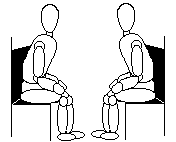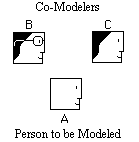The NLP Pattern of the Month:
Some Beginning Modeling Drills and Exercises
The purpose of the following exercises is to provide some experience with the basic processes and procedures of modeling. They primarily focus on the information gathering phase of the modeling process, and cover a range of modeling skills, including "implicit" and "explicit" modeling formats, and the use of multiple perceptual positions to gather different types and levels of information about a particular performance.
Mirroring Exercise
Mirroring is a method of building a strong "second position" with someone else. It is a fundamental skill for modeling another person and for developing intuitions about the person's internal experience. To get a sense of the influence and effects of mirroring, try out the following exercise.
- Choose a partner, or person to converse with. Do not tell the person initially that you will be mirroring him or her during the conversation.
- Enter into a conversation with the person, asking for his or her opinions about various subjects.
- As you are conversing, begin to subtly mirror the other person's physiology (including voice tone and tempo). [Hint: This can be most easily done in the context of 'active listening'; that is, reflecting back statements the person has made, by commenting, "So what you are saying is....", and then stating your understanding of the person's opinion.]
- When you are fully mirroring, you will be sitting in the same posture, using the same types of gestures, speaking at a similar speed and volume, and in a similar voice tone range, as the other person. If you are completely mirroring the other person, you will even be breathing at the same rate and in the same part of the chest cavity as the other. Notice what it feels like when you have reached this level of rapport.
- One way to test your degree of rapport is by "second guessing" the other person's opinion on a couple of subjects that you have not yet discussed. Often mirroring will give you access to information that is being unconsciously communicated and received, and you will "pick up" information about the other person without being consciously aware of how you got it. This is why mirroring is such a powerful tool for modeling.
- To get another sense of the influence of mirroring on your interaction, you can try out what it is like to abruptly mismatch the other person in posture, gestures, voice tone and breathing. Both you and your partner should experience quite a jolt if you do this, and feel as if your quality of rapport has changed dramatically.
- Before concluding your conversation and letting your partner in on what you were doing, make sure you have reestablished rapport by once again physically mirroring your partner.

Mirroring Involves Matching the Physical Patterns of Another Person
"Implicit" Modeling from Second Position
This exercise is to be done with four persons: (1) the Person to be modeled, (2) a Subject to interact with the individual being modeled, (3) a Modeler, and (4) an Observer
- The Subject and the Person to be modeled engage in a conversation (for approximately 5 minutes) about a topic, chosen by the Person being modeled. The Modeler "implicitly" models the Person by going to 'second position' with the person, and focusing the on the micro muscle movements of the individual.
- The Modeler then 'stands in' for Person he or she has been modeling i.e., the Modeler continues the conversation with the Subject "as if" he or she were that Person.
- The Modeler is to receive explicit feedback and coaching by the Person being modeled and the Observer about how accurately he or she is acting like the Person being modeled. (If the Modeler expereinces difficulty, you can repeat steps 1 & 2 another time.)
- The Modeler is then sent out of the room, and the Subject and the Person being modeled converse about a different topic (5 min.), chosen by the Subject this time.
- When the Modeler returns, he or she is to once again "stand in" for the Person being modeled, and converse with the Subject about the new topic "as if" he or she were that Person. (The Subject should try to replicate the order of the questions and interaction of the conversation as much as possible.)
- After about 5 minutes, the Subject, Observer and the Person who has been modeled are to give the Modeler feedback as to how accurately his or her performance matched that of the Person being modeled.
Building Double and Triple Descriptions Through 'Co-Modeling'
The process of Co-Modeling involves the participation of two people in the modeling process to build a "double-description" and "triple-description" of the process to be modeled. Co-Modeling allows for the immediate intertwining of both the explicit and implicit modeling processes. In much the same way that our two eyes see depth by giving us a 'double-description' of the visual world around us, Co-Modeling gives depth to the modeling process by providing multiple simultaneous perspectives of the same subject.
These exercise are to be done in groups of three (A, B & C): A = Person to be Modeled; B & C = Modelers.

Exercise 1: Building Intuitions Using Second Position
- Person A demonstrates a simple behavioral skill to be modeled (e.g., a dance step, a culturally related gesture or greeting, entering a particular resource state, etc.).
- Persons B & C go into a state of "not knowing," and enter into 'second position' with A for a few minutes.
- B & C then write down explicitly what they think is going on in A based on their implicit experience gained from 'second position'.
- B & C compare their models, identifying similarities and differences between their two descriptions.
- A, B & C then work together to create a "triple description" of the key elements of the behavioral skill demonstrated by A.
Exercise 2: "Explicit Modeling" Using Third Position
- Person A demonstrates a simple behavioral skill to be modeled.
- Staying in a 'third position', or 'observer' position, persons B & C have 10 minutes to elicit verbal information and behavioral demonstrations from A, in order to get explicit information about the skill being modeled.
(Note: B & C may ask about any level of information_ i.e., physiology, representational systems, language patterns, T.O.T.E., metaprograms, beliefs, etc. They can explore any level of information they think will provide the most useful information about the skill being modeled.)
- B & C then write down explicitly what they think is going on inside A, based on their observations and the information that they have elicited.
- B & C compare their models, identifying similarities and differences between the two descriptions.
- Again, persons A, B & C work together to create a third description of the key elements of the behavioral skill demonstrated by A.
Notice the different dynamics and quality of information that comes from the two exercises.
Exercise 3: Modeling States of Excellence Combining Second and Third Position
- Person A selects and domonstrates an example of a personal resource state, or "state of excellence."
- Person B models A implicitly, using 2nd position.
- Person C models A explicitly, from 3rd position. C asks 'why' questions which address beliefs, values, metaprograms, meta-outcomes; and 'how' questions which address goals, evidences and operations (the T.O.T.E. distinctions).
- Person A now chooses an experience which is opposite to the first example (i.e., a "stuck state").
- B & C repeat steps 2 and 3 above.
- B & C compare and contrast their own models of A's examples of excellence and its opposite, and explore what is similar and what is different about their descriptions.
Group Modeling
The process of co-modeling can be generalized to an entire group. The following is an exercise that allows a whole group to get involved in the modeling process, and form a "triple description."
- The group selects a skill from a trainer, or from another person (from outside group), that the group is interested in learning or knowing more about.
- The group divides into two teams A & B. Team A uses 2nd position, and team B uses 3rd position, to develop descriptions of the skill to me modeled.
- The person to be modeled dmonstrates several examples of the skill, and each team generates a description, using the position they have been assigned. Members of the 3rd position team (B) may choose to focus on different levels of distinctions (physiology, language patterns, cognitive strategies, beliefs, etc.) in order to form their descriptions.
- Team delegates then summarize the findings and descriptions of their teams to the rest of the group, and the whole group synthesizes the descriptions into a common model.
Also see the Article of the Month or the Archives if you are interested in checking out NLP in more depth.
For information on Robert Dilts’ products and services, please see Upcoming Seminars or Robert’s Product Page or return to Home Page.
If you have problems or comments concerning our WWW service, please send e-mail to the following address: michaelp@bowsprit.com.
This page, and all contents, are Copyright © 1998 by Robert Dilts., Santa Cruz, CA.


